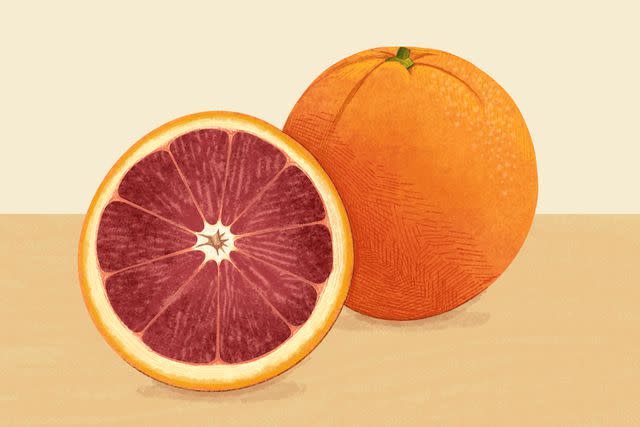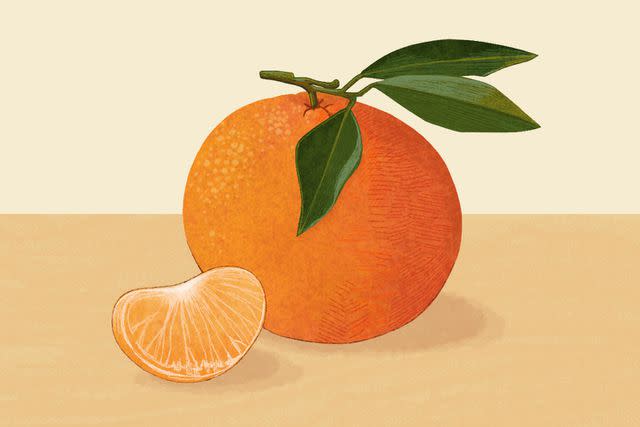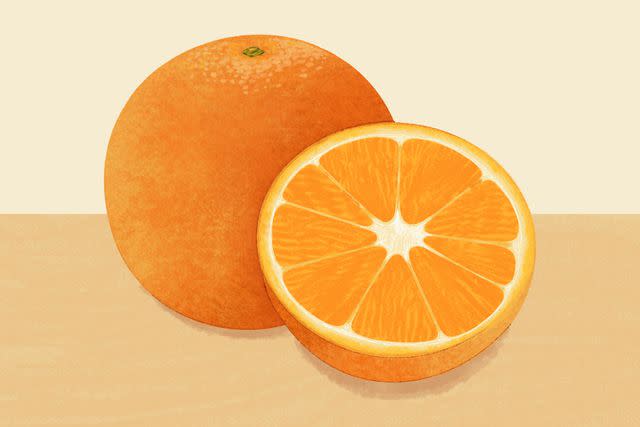A Guide To 9 Common Types Of Oranges
Learn about your options for snacking, baking, drinking, and more.

Corinne Mucha
We know oranges are a great source of vitamin C. Historically, they were given to sailors to help prevent scurvy on long trips overseas.
They’re versatile, too. Juice some for a quick morning pick-me-up, use them for a bright jam, or squeeze them to complete your mojo marinade for your next pork tenderloin. The possibilities are endless.
But there are many varieties of oranges, all with their own qualities that make them the best choice for adding some kick to next your roast chicken, smoothing out your holiday cocktails, and bringing just the right level of tart to your cranberry sauce.
According to Natalie Sexton, vice president of marketing at Natalie’s Orchid Island Juice in the renowned Indian River region of Florida, it’s all about the brix-to-acid ratio in each piece of fruit. “Brix is the metric of sugar content, and acid is literally the acid in the fruit. It's this ratio of sugar to acid that makes the perfect taste when it comes to juice out of an orange,” says Sexton.
This guide to the many types of oranges will help you navigate the towers of citrus fruits populating grocery stores and farmers' markets throughout the citrus season (October through May for most). And don’t fret if you get excited and buy too many. They can be stored out on the counter in a cool, dark spot, in the crisper, or even frozen.
Navel

Corinne Mucha
Navel oranges are probably the most popular oranges at the store. Even when other varieties are not available, navels are a staple.
The relatively large size and thick skin make them easy to peel. The lack of seeds adds to their allure as a quick snack or as an addition to salads. They are sweet, and the zest is a great stir-in to baked goods like scones, muffins, and breads.
You can distinguish these common oranges by their signature mark, a belly button-looking indention on the bottom of the fruit.
This is not the orange for a glass of fresh-squeezed juice as its sweetness fades fast. Their magic is as an ingredient. “Navels have no seeds which makes them preferred by chefs and home cooks in recipes.
Cara Cara

Corinne Mucha
Cara Caras are a type of navel orange, but with delicate pink flesh and low acidity, and no sharpness or tang when you bite in, just refreshing sweetness. They're often called red-fleshed navel oranges, so don’t confuse this beauty for a blood orange.
In season, December through April, Cara Cara oranges are great for snacking, salads, and juice. They have minimal seeds and a skin that is easy to peel. There are also hints of berries and cherries in their flesh, making them a great choice for smoothies once deseeded.
Blood Orange

Corinne Mucha
These citrus stunners often have splotches of red on their skin and crimson flesh inside. Blood oranges are a hybrid of the pomelo and the tangerine and are highly coveted for baking because of their ample juice. Plus, their flavor is a mix of tart orange and ripe raspberry, with a hint of floral. This combo makes blood orange a great addition to cakes, sauces and even marmalades.
Blood oranges also make a visually stunning garnish for seasonal cocktails and gorgeous additions to snack boards. Some popular types are—Moro, Sanguinello, and Tarocco—ranging from tart to sweet. They can be found on display from December through May, but mostly during their peak season of February to early March.
"Blood orange tastes like a combination of orange and grapefruit. It has tremendous flavor and zest, but it's definitely on the more bitter side of the spectrum. We produce a blood orange juice and found that the highest quality blood orange with the ratios of sugar to acid we prefer for palatability is grown in Italy,” adds Sexton.
Related: Blood Orange Holiday Punch
Tangelos

Corinne Mucha
As a young girl, Sexton would go into the groves and pick tangelos right off the tree to eat because of their phenomenal taste. A hybrid between a tangerine and orange or grapefruit, they offer a super-sweet flavor tempered with just a bit of tartness. They are easily distinguishable with their deep orange color, bell shape, and “nipple” poking out of the top of the fruit. The skin is tighter, making it more challenging to peel for an easy snack, but the flesh inside is juicy—perfect for a tall glass of juice. Keep an eye out for them from December through March, with peak season in January.
Tangerine

Corinne Mucha
These small, brightly-colored citrus fruits are technically not an orange, but a type of mandarin. They have loose, easy-to-peel skin and a sweet flavor that makes them a great choice for snacking, juicing, and baking. They also are great additions to winter salads and cocktails, but they do have seeds. They are cousins to the clementine, which is a seedless version of a tangerine. They have a long season from November through May.
Valencia

Corinne Mucha
“Valencia is the queen of juice,” according to Sexton (and most juice producers). Named after Valencia, Spain, this oval-shaped, golden-orange-colored citrus has incredibly juicy flesh. They are sweet, have the ideal brix-to-acid ratio, and probably are the base for your favorite orange juice. Their skin is thin and doesn’t have the limonin compound responsible for making juice bitter after being exposed to air, but they do have seeds. Grown mostly in Florida and California, they see peak season over the summer from April through June, making them a great year-round choice for some vitamin C.
Mandarins

Corinne Mucha
If you’ve ever tried to make a key lime pie by juicing fresh key limes, you’ll understand why you won’t want to squeeze fresh mandarins for a glass of juice—they’re too petite. But they are the perfect lunchbox snack. The skin is loose for easy peeling, they have an enticingly sweet flavor, and they are practically seedless. Mandarins are stunners on winter salads and make great additions to cakes and curds. You can also find them canned for those festive gelatin salads year-round. Clementines, Satsumas, tangerines, and tangelos are all types of mandarins and can be found in season January through May.
Clementines

Corinne Mucha
When you see those bags of “Cuties,” “Halos,” “or “Sweeties,” you are looking at clementines. This adorable miniature, honey-sweet citrus is seedless and the perfect afternoon pick-me-up. The skin is tight but thin, easy to peel, and there is very little pith, making them a great choice for kids.
Though the season for clementines is November through January, growers have started introducing “Summer Cuties” because of their wide appeal year-round.
Seville

Corinne Mucha
One of the least common oranges, Sevilles are also called bitter or sour oranges because of their extreme tartness and high acidity. They have a pale orange exterior and almost lemon-colored flesh. There are lots of redeeming things about this never-to-be-eaten raw variety, however. The peels make delicious candied orange confections. In marmalades, they are the perfect foil to all that sugar. The juice makes tasty marinades and salad dressings. Their season is fleeting though, just January to March so snap them up for some holiday cooking.
For more Southern Living news, make sure to sign up for our newsletter!
Read the original article on Southern Living.

